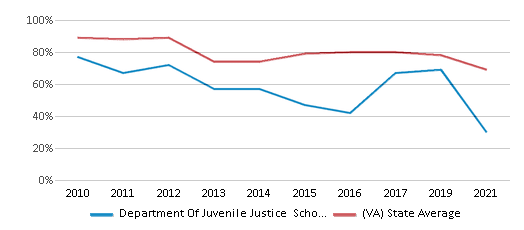For the 2025 school year, there is 1 public school in Department Of Juvenile Justice School District. This district's average testing ranking is 3/10, which is in the bottom 50% of public schools in Virginia.
Public School in Department Of Juvenile Justice School District have an average math proficiency score of 50% (versus the Virginia public school average of 54%), and reading proficiency score of 30% (versus the 70% statewide average).
Overview
This School District
This State (VA)
# Schools
1 School
2,143 Schools
# Students
n/a
1,257,585 Students
# Teachers
n/a
92,187 Teachers
Student : Teacher Ratio
n/a
n/a
District Rank
Department Of Juvenile Justice School District, which is ranked within the bottom 50% of all 135 school districts in Virginia (based off of combined math and reading proficiency testing data) for the 2020-2021 school year.
Overall District Rank
#103 out of 135 school districts
(Bottom 50%)
(Bottom 50%)

Math Test Scores (% Proficient)
(20-21)<50%
54%

Reading/Language Arts Test Scores (% Proficient)
(20-21)21-39%
69%

Science Test Scores (% Proficient)
(20-21)<50%
59%
Students by Ethnicity:
Diversity Score
-
0.72
# American Indian Students
n/a
3,271 Students
% American Indian Students
n/a
n/a
# Asian Students
n/a
96,235 Students
% Asian Students
n/a
8%
# Hispanic Students
n/a
243,979 Students
% Hispanic Students
n/a
19%
# Black Students
n/a
270,294 Students
% Black Students
n/a
22%
# White Students
n/a
555,515 Students
% White Students
n/a
44%
# Hawaiian Students
n/a
1,963 Students
% Hawaiian Students
n/a
n/a
# Two or more races Students
n/a
86,328 Students
% of Two or more races Students
n/a
7%
Students by Grade:
# Students in PK Grade:
-
34,534
# Students in K Grade:
-
85,239
# Students in 1st Grade:
-
89,472
# Students in 2nd Grade:
-
93,456
# Students in 3rd Grade:
-
89,973
# Students in 4th Grade:
-
91,712
# Students in 5th Grade:
-
92,190
# Students in 6th Grade:
-
93,262
# Students in 7th Grade:
-
93,323
# Students in 8th Grade:
-
93,990
# Students in 9th Grade:
-
105,013
# Students in 10th Grade:
-
103,738
# Students in 11th Grade:
-
97,088
# Students in 12th Grade:
-
94,595
# Ungraded Students:
-
-
Best Department Of Juvenile Justice School District Public Schools (2025)
School
(Math and Reading Proficiency)
(Math and Reading Proficiency)
Location
Grades
Students
Rank: #11.
Yvonne B. Miller High School
Alternative School
(Math: <50% | Reading: 21-39%)
Rank:
Rank:
2/
Bottom 50%10
600 E. Main Street, Floor 20
Richmond, VA 23219
(804) 371-0700
Richmond, VA 23219
(804) 371-0700
Grades: 6-12
| n/a students
Frequently Asked Questions
How many schools belong to Department Of Juvenile Justice School District?
Department Of Juvenile Justice School District manages 1 public schools.
What is the rank of Department Of Juvenile Justice School District?
Department Of Juvenile Justice School District is ranked #102 out of 135 school districts in Virginia (bottom 50%) based off of combined math and reading proficiency testing data for the 2020-2021 school year.
Recent Articles

Year-Round Or Traditional Schedule?
Which is more appropriate for your child? A year-round attendance schedule or traditional schedule? We look at the pros and cons.

Why You Should Encourage Your Child to Join a Sports Team
Participating in team sports has a great many benefits for children, there is no doubt. In this article you will learn what those benefits are.

White Students are Now the Minority in U.S. Public Schools
Increasing birth rates among immigrant families from Asia and Central and South America, combined with lower birth rates among white families, means that for the first time in history, public school students in the United States are majority-minority. This shift in demographics poses difficulties for schools as they work to accommodate children of varying language abilities and socio-economic backgrounds.





